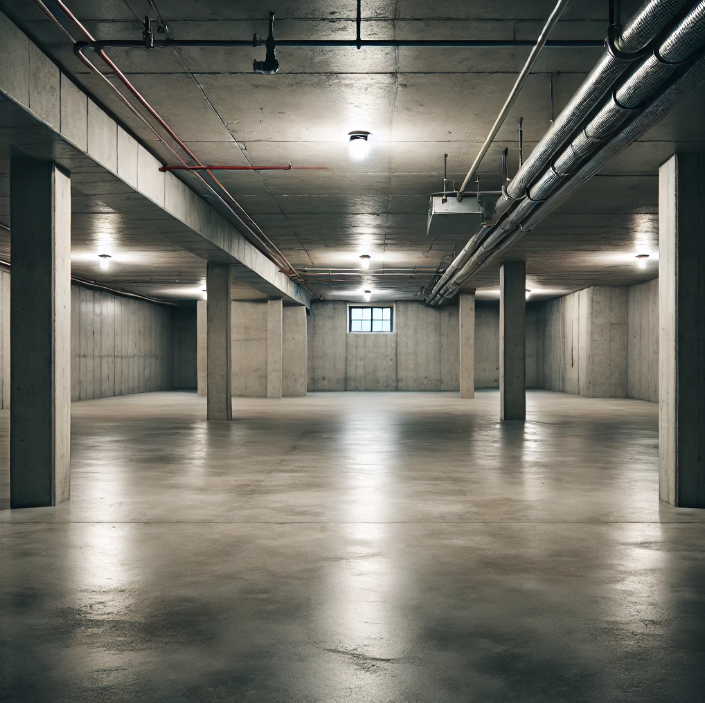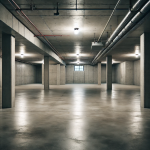When you're combating moisture problems in your home, finding the right waterproofing solution for your inside walls can feel like a challenging task. Interior water drainage systems, waterproof primers, sealants, wall panels, crystalline waterproofing, and silicone sealants all have their place in the arsenal. But, which one is the best? The answer might not be as straightforward as you think, with the most effective solution often depending on your specific situation. Let's unpack this together and navigate the somewhat murky waters of interior wall waterproofing.
Key Takeaways
- Silicone sealants offer durability, flexibility, and easy application, making them an effective waterproofing solution for inside walls.
- Crystalline waterproofing provides a long-term solution, creating a waterproof crystal structure within the wall.
- Waterproofing membranes can provide a comprehensive barrier against moisture, although installation is more labor-intensive.
- Waterproof paint is an affordable and versatile option, enhancing the aesthetic appeal of walls while providing a degree of moisture protection.
- Silicate-based concrete sealers are particularly effective for waterproofing concrete walls, forming a durable waterproof layer.
Understanding Indoor Wall Moisture Issues
A staggering majority of homeowners encounter moisture issues in their indoor walls at some point. It's not always a sign of catastrophe, but it's not something you should ignore either.
You might notice discoloration on your walls, a musty smell, or even mold growth. These are warning signs that there's excess moisture trapped within your walls, and it's time to take action.
Moisture within your walls can result from many factors. It could be due to poor ventilation, leaky pipes, or even high humidity levels in your house.
When you ignore these signs, you're not only risking structural damage to your home but also potentially compromising your health. Prolonged exposure to dampness can lead to mold and mildew, which can cause allergic reactions and respiratory issues.
Understanding what causes moisture in your walls is the first step to addressing the problem. Once you've identified the source, you can take the necessary steps to fix it.
This might involve improving ventilation, repairing leaks, or investing in a dehumidifier. But remember, prevention is always better than cure. Regular maintenance of your home can prevent moisture issues from cropping up in the first place.
Importance of Proper Wall Waterproofing
You can't overlook the importance of proper wall waterproofing.
It's your first line of defense against moisture damage, protecting your home's essential structure.
Plus, the benefits of waterproofing extend beyond protection - it adds value to your home by maintaining its health and integrity.
Preventing Moisture Damage
Proper wall waterproofing plays an essential role in preventing moisture damage. Without it, you're allowing water to seep into your walls. This can lead to a whole host of problems, including mold and mildew growth, structural damage, and an unhealthy living environment.
Imagine coming home to find your walls damp and discolored. You'd be distressed, right? Now, think about the potential health issues that come with living in such conditions. Mold and mildew can trigger allergies, respiratory problems, and other health concerns. That's not a situation you'd want to find yourself in.
Your home is your fortress. It's where you feel safe and comfortable. That's why it's vital to guarantee that your walls are effectively waterproofed. It's not just about maintaining the aesthetics of your home, it's about preserving its structural integrity and guaranteeing a healthy living condition for you and your family.
In short, neglecting proper wall waterproofing isn't worth the risk. The time, effort, and resources you'll spend in addressing moisture damage far outweigh the cost of preventative measures.
Benefits of Waterproofing
Think about the peace of mind you'll have knowing your home is protected from harmful moisture. Waterproofing your walls offers several benefits you mightn't have considered.
Firstly, it extends the lifespan of your walls. Water can seep into walls, causing them to weaken over time. By waterproofing your walls, you're preventing this damage and ensuring they remain strong for years to come.
Next, waterproofing can greatly reduce your maintenance costs. Water damage can lead to costly repairs, from painting over water stains to replacing entire sections of the wall. When your walls are waterproof, you're saving yourself from these potential expenses.
Waterproofing also promotes a healthier living environment. Moisture can lead to mould growth, which can have serious health implications. By keeping your walls dry, you're preventing mould growth and protecting your family's health.
Lastly, a well-maintained, waterproofed home can increase your property's value. Prospective buyers will appreciate the care you've taken to prevent water damage, making your home more attractive and potentially boosting its resale value.
Different Types of Interior Wall Waterproofing
Charting the sea of interior wall waterproofing options can sometimes feel overwhelming. But don't worry. You've got a variety of options to protect your home from the damaging effects of moisture.
First, there's the interior water drainage system. It's a popular method for basements as it collects water that seeps inside and directs it to a sump pump, away from your property.
Next, consider waterproof primers and sealants. You apply them just like paint, forming a barrier that blocks out moisture. They're best for walls already in good condition, needing a preventive measure against potential water damage.
Lastly, let's talk about waterproof wall panels. They're durable, mold-resistant, and can even add an aesthetic touch to your interior.
To sum it up:
- Interior water drainage systems are great for basements.
- Waterproof primers and sealants work best as preventive measures.
- Waterproof wall panels offer durability and aesthetic appeal.
Choosing the right option depends on your specific needs and circumstances. It's essential to understand the nuances of each method to make the best choice for your home.
The Pros and Cons of Waterproof Paints
While waterproof paint might seem like an easy solution for your interior walls, it's crucial to weigh its advantages and drawbacks before making a decision.
On the upside, it's a versatile option that you can apply on various surfaces, including concrete and masonry. It's also cost-effective, requiring fewer layers compared to other solutions. The application is straightforward; you'll only need a brush or roller—no specialist tools.
It also enhances your walls' aesthetic appeal, available in various colors, and can cover up unsightly stains or discolorations.
However, it's not all rosy. One significant drawback is its durability—or lack thereof. Waterproof paints can peel or chip over time, especially in high humidity or fluctuating temperatures.
This issue requires frequent touch-ups, which can be time-consuming and costly. It mightn't fully prevent water seepage, especially if the source of moisture isn't adequately addressed.
It's also less effective on porous materials, like brick, as they can absorb the paint, reducing its waterproofing capabilities.
Silicone Sealants: An Effective Solution?
Ever thought about the benefits of silicone sealants for waterproofing your interior walls?
Well, it's an effective solution you shouldn't overlook.
Let's simplify its application process and help you understand why it's a popular choice.
Benefits of Silicone Sealants
One may wonder, what makes silicone sealants a popular choice for waterproofing inside walls? The answer lies in their unique properties and benefits that you mightn't find in other types of sealants.
Silicone sealants are known for their ability to create a strong and durable barrier against water. This makes them an excellent choice for waterproofing your interior walls. But that's not all, they've more to offer.
- Flexibility: Silicone sealants remain flexible even after they've dried. This means they can accommodate movement and shifts in your walls without cracking or breaking down. It's a quality you'll appreciate, especially in areas prone to temperature changes or seismic activities.
- Longevity: They're resistant to UV rays, extreme temperatures, and weathering. This makes them last longer than other types of sealants. So, you won't have to worry about frequent reapplications.
- Non-toxic: Once cured, silicone sealants are safe and non-toxic. They don't release harmful fumes, making them an environmentally-friendly choice for your home.
Application Process Simplified
Now that you understand the benefits of silicone sealants, let's look at how easy it's to apply them to your interior walls. The process is straightforward, even for beginners.
First, you'll need to clean the surface of your walls. Any dust or dirt can prevent the sealant from adhering properly. A damp cloth should do the trick.
Then, you'll apply the silicone sealant using a caulking gun. It's as simple as squeezing the trigger and moving the gun along the area you want to seal. No special technique is required, but it's best to move at a steady pace to guarantee an even application.
Once you've applied the sealant, you'll need to smooth it out. A simple tool like a spatula or even a finger can be used for this task. Just be sure to wear gloves if you choose the latter.
Finally, you'll need to let the sealant cure. This can take up to 24 hours, but it's worth the wait for a long-lasting waterproof seal.
With these steps, you've got a solution that's not just effective, but also easy to apply. And that's the beauty of silicone sealants.
Other Noteworthy Waterproofing Techniques
Beyond the conventional waterproofing methods, there are some unique techniques within your reach that could prove equally effective.
You shouldn't limit yourself to the mainstream options; there's more to waterproofing than meets the eye.
The first technique you might want to evaluate is crystalline waterproofing. It's a high-tech solution that involves the use of a special mix that reacts with water and concrete to create a waterproof crystal structure within the wall.
It's not just a barrier; it actually transforms the wall itself.
Another technique involves the use of a waterproofing membrane. This is a physical barrier that's applied to the wall.
It's a bit more labor-intensive, but it offers robust protection against water ingress.
Lastly, contemplate the use of silicate-based concrete sealers. These work by reacting with the ingredients in the concrete to form a waterproof layer.
- Crystalline Waterproofing: A transformative solution for your wall.
- Waterproofing Membranes: A labor-intensive but robust option.
- Silicate-Based Concrete Sealers: A chemical reaction that offers protection.
Frequently Asked Questions
Can I Waterproof My Interior Walls by Myself or Do I Need a Professional?
Yes, you can waterproof your interior walls yourself. It's a manageable DIY project if you're handy. However, for more complex situations, or if you're unsure, it's best to hire a professional to guarantee a thorough job.
How Frequently Should I Reapply Waterproofing to My Interior Walls?
You'll need to reapply waterproofing depending on the product used and wall condition. Typically, it's every 3-5 years. However, if you notice dampness, peeling paint, or mold, it's time to reapply sooner.
Are There Eco-Friendly Options for Interior Wall Waterproofing?
Absolutely, there are eco-friendly options! You'll find products like Safecoat DynoSeal, a low odor, waterborne coating that's safe for you and the environment. It's a great choice for waterproofing your interior walls responsibly.
Does Wall Waterproofing Affect My Homes Insulation?
Yes, wall waterproofing can impact your home's insulation. It can actually enhance insulation by preventing dampness, which reduces thermal efficiency. However, it's essential to choose a product that's compatible with your existing insulation materials.
Can I Apply Wallpaper or Paint Over the Waterproofing Layer?
Yes, you can. After the waterproofing layer's fully dried, you're free to paint or wallpaper over it. However, make certain you're using materials compatible with the waterproofing, so it doesn't compromise its effectiveness.
Conclusion
So, you've got options when it comes to waterproofing your indoor walls. Whether it's water drainage systems, sealants, or wall panels, the best choice depends on your specific moisture issues. Consider long-term solutions like crystalline waterproofing for lasting protection. Remember, the right waterproofing not only protects your walls but also enhances their longevity and appeal. So, assess your situation carefully, choose wisely, and say goodbye to moisture problems for good.





